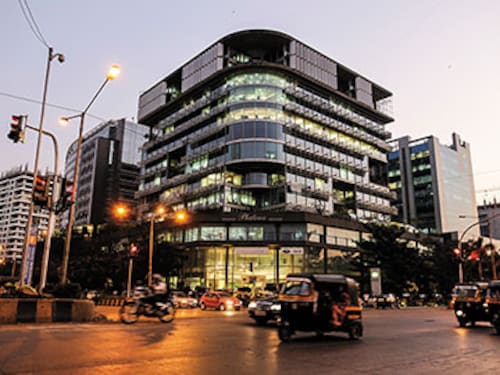The Design-Profit Conundrum in Real Estate
Architects and developers dwell on the challenge of meeting customer needs aesthetically and, yet, with a firm eye on commerce


It’s a timeless clash: The tug-of-war between aesthetics and cold hard cash. And the urban Indian landscape has long been its battlefield. Now, as cities grow faster and taller, using superior material and technology, projecting modernity and progress, the conflict is only intensifying. But the winner is apparent when you look beyond the multitude of cranes and towers of concrete and glass: Design is clearly losing its tussle with profit.
The majority of developers ignore traditional elements of Indian architecture that have been adapted to suit local needs.
Fenestrations (openings in walls), thickness of walls and courtyards all contribute to improving ventilation. But these are missing from the contemporary urban sprawls that are indifferently executed. Ugly buildings with environmentally unfriendly glass facades dominate the cityscape. This trend has even permeated to smaller towns.
This is in stark contrast to international patterns in which urban design and planning is moving towards sustainable environments with long-lasting structures. Such buildings are part of a larger vision where new approaches focus on developing cities that offer ease of commute, green lungs and other amenities geared towards improving the quality of life.
Not surprisingly, the intelligent Indian buyer is slowly realising that living in a penthouse in a luxury tower may not always guarantee that life. For instance, a millionaire IT entrepreneur says he decided against buying a penthouse in a 100-storey building coming up in south Mumbai because it would take him an hour to get in and out of the cramped roads leading up to it.
“Most developers will only try to make money,” points out Kamal Malik, founder of design house Malik Architecture, who feels that in such a profit-driven market, there is no possibility for innovation in architecture. Born and raised in Shimla in Himachal Pradesh, Malik draws deeply from nature. His buildings are typically around 30 percent more expensive than those built by others but he is unapologetic: He claims they are more sustainable and of better quality. Malik is the architect for Adhiraj Developers’ 50-acre middle-income housing complex at Khargar in Navi Mumbai, where the buildings are being designed such that every five floors are linked to create a minor eco-system or ‘neighbourhood in the sky’. There will be gardens and open spaces—aspects that Malik hopes will help strike a balance between concrete and nature.
In cities such as Mumbai, where space is at a premium, real estate prices are rising in direct proportion to the height of new buildings, and developers are utilising every available inch. “Everyone in Mumbai is always short of one room. The chap with the two-bedroom house and the rich man with five bedrooms—all of us always want that one extra room,” says veteran real estate consultant Pranay Vakil. It’s this thirst for space that’s driving contemporary design sensibility. Architect Anubhav Gupta, executive vice-president and head of design strategy at Godrej Properties, says design is now officially a brand pillar for his company. “Our approach is design led,” he says. That said, it’s common for the firm’s designers to don business hats for a better understanding of project costs. They also have a say in whether to seal a property deal or not.
The Godrej family are protectors of Mumbai’s largest stretch of undisturbed mangroves and have always believed in sustainability, says Gupta who has studied urban planning and has a PhD in real estate finance from the University of Cambridge, UK. Their buildings are designed to be eco-friendly and conserve water, he says. Flat owners at Godrej Properties’ projects are given a sustainability manual along with their house keys. The manual shows residents ways to maximise resources.
Luxury developers are also hawking branded interior designers to attract buyers. A Knight Frank report on Indian real estate in 2013 said that using international interior designers has become an important factor in the competitive market for luxury homes. Big developers such as DLF, BPTP Builders and Supertech in the NCR, and the Lodha group and Panchsheel in western India, have tied up with Giorgio Armani, Philippe Starck and Jade Jagger to build bespoke homes.
Joe Verghese, managing director of Colliers International, says buyers are often dictated by a range of parameters. In Hyderabad, for instance, Vaastu plays an important role in how houses are built and sold. Local preferences and fads could range from a puja room to marble-and-glass lobbies and, more recently, podium gardens.
Branded residential apartments can cost between Rs 10 crore and Rs 50 crore, depending on location. To foster the feeling of exclusivity, developers offer a choice of fittings, furnishings and themes that fall within the designer’s range. Private sky gardens and home theatres are also on offer.
Babulal Varma, promoter and managing director of Omkar Realtors, doesn’t set too much store by interior designer-branding. Omkar is developing luxury properties including a big project at Worli, in south Mumbai, that offers 18,000 sq ft castles in the sky. They have hired Foster + Partners, London-based architects, and other specialist firms for interiors and lighting design. Varma says creating the luxury of space is critical to his projects.
Such cosmetic measures and piecemeal efforts may not truly offer residents an improved quality of life, say critics. City planning agencies will need to have a greater role if things are to change, says Malik. He suggests establishing independent agencies and planning codes that make it mandatory for architects and developers to work with urban planners. “Our whole approach to urban design has to change.”
First Published: May 13, 2014, 06:21
Subscribe Now